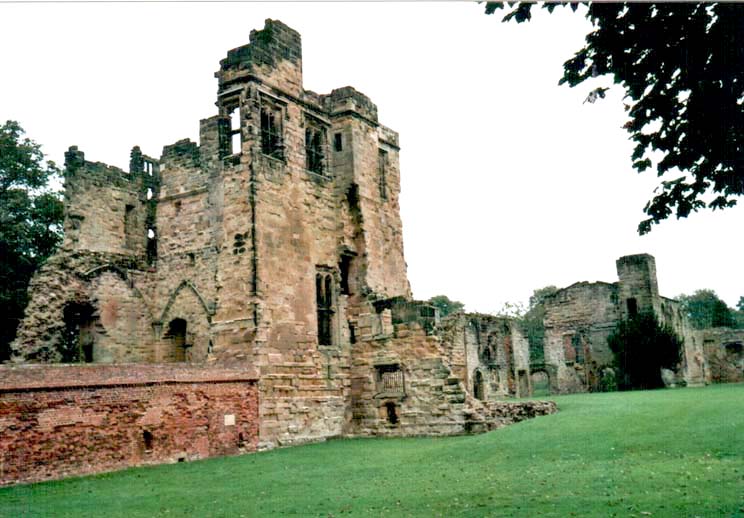Other Lovell Castles

Acton
Burnell Castle is situated in Shropshire, in the village of the same
name. There was a manor house there already in the twelfth century. The
ruins that can be visited today belong to the building built by Robert
Burnell, bishop of Bath and Wells and chancellor of
Edward I. Robert Burnell received license to crenellate in 1284. In the
same year a parliament was held in Acton Burnell. The building erected
by Robert Burnell is not strictly speaking a castle as it was not
fortified.
The central hall is almost all that remains of the castle. It was built of red sandstone and the lower floor was the residence of the bishop's attendants and possibly steward. On the first floor the bishop's own appartments would have been situated. In the eighteenth century the hall was used as a barn. The doorway visible on the picture on the right dates from this period. The kitchen, stables and other service buildings must have been of timber and no traces of them remain.
The central hall is almost all that remains of the castle. It was built of red sandstone and the lower floor was the residence of the bishop's attendants and possibly steward. On the first floor the bishop's own appartments would have been situated. In the eighteenth century the hall was used as a barn. The doorway visible on the picture on the right dates from this period. The kitchen, stables and other service buildings must have been of timber and no traces of them remain.


The Lovells acquired Acton Burnell with the remainder of the Burnell estates in 1420. Their claim was derived from Maud Burnell, sister and heiress of Edward Burnell, who had been married to John Lovell IV. However, the largest part of the Burnell estates were originally entailed by Maud Burnell on her sons from her second marriage to John Haudlo. Their grandson, Hugh Burnell died in 1420 without heirs male. In 1416, Hugh Burnell had settled Acton Burnell and other estates on his granddaughter Katherine, daughter of his son Edward who had died in 1415, but as the estates had were held in tail male the Burnell estates, including Acton Burnell, went to William Lovell III.
William Lovell III, however, never used Acton Burnell as a residence and the buildings were left to go to ruins. They are now in the care of English Heritage.
The
Lovells had close connections to the Zouches of Harringworth,
originally a cadet branch of the Zouches of Ashby. In 1461, John Lovell
IX occupied the castle of Ashby-de-la-Zouche, expelling the garrison of
James Butler, earl of Wiltshire Ormond. His reason for
doing so are not clear, but it is possible that he laid claim on the
estate as part of the inheritance of his wife Joan Beaumont, whose
father had been killed in the battle of Northampton the previous year.
However, Edward IV granted Ashby-de-la-Zouche to William Hastings who added new buildings to the castle, including the Hastings Tower. Like many other castles, Ashby was besieged during the Civil War and large parts destroyed. The ruins remained impressive enough for Sir Walter Scott to set the tournament in "Ivenhoe" there.
However, Edward IV granted Ashby-de-la-Zouche to William Hastings who added new buildings to the castle, including the Hastings Tower. Like many other castles, Ashby was besieged during the Civil War and large parts destroyed. The ruins remained impressive enough for Sir Walter Scott to set the tournament in "Ivenhoe" there.

Chepstow
Castle on the River Wye was built by William fitz Osbern, a close
friend of William of Normandy (the Bastard/Conqueror). William fitz
Osbern's son
William de Breteuil was embroiled in a long conflict about the
castle of Ivry on the Norman-French border with Ascelin Goël,
an early ancestor of the Lovells and the founder of the family's
fortunes.
Visiting Chepstow with Kirsty a few years back I was therefore delighted to come across William fitz Osbern in person.
Visiting Chepstow with Kirsty a few years back I was therefore delighted to come across William fitz Osbern in person.


After the
death of his father John Lovell IX in 1465, Francis Lovell became a
ward of Richard Neville, earl of Warwick. Francis, possibly accompanied
by his sister Joan and Frideswide, certainly spent some of his
childhood in Middleham Castle, Richard Neville's residence in
Yorkshire. Contrary to popular tradition it is not clear whether he met
Richard, duke of Gloucester (i.e. the future Richard III) then, as
Richard left the earl of Warwick's care about this time.
Francis Lovell was married to Anne FitzHugh, daughter of Richard Neville's sister, and seems to have stayed at the FitzHugh seat of Ravensworth in 1471. He spend a large part of his adult life in the north and became a steadfast companion to the duke of Gloucester when the latter was living at Middleham.
Francis Lovell was married to Anne FitzHugh, daughter of Richard Neville's sister, and seems to have stayed at the FitzHugh seat of Ravensworth in 1471. He spend a large part of his adult life in the north and became a steadfast companion to the duke of Gloucester when the latter was living at Middleham.
Radford, C.A. Ralegh, ‘Acton Burnell Castle’, in E.M. Jope (ed.), Studies in Building History (London, 1961), 94-103.
Simon, M.E., 'The Lovells of Titchmarsh. A Late Medieval Baronial Family (1297-148?)', (unpubl. DPhil Thesis, University of York, 1999).
Home